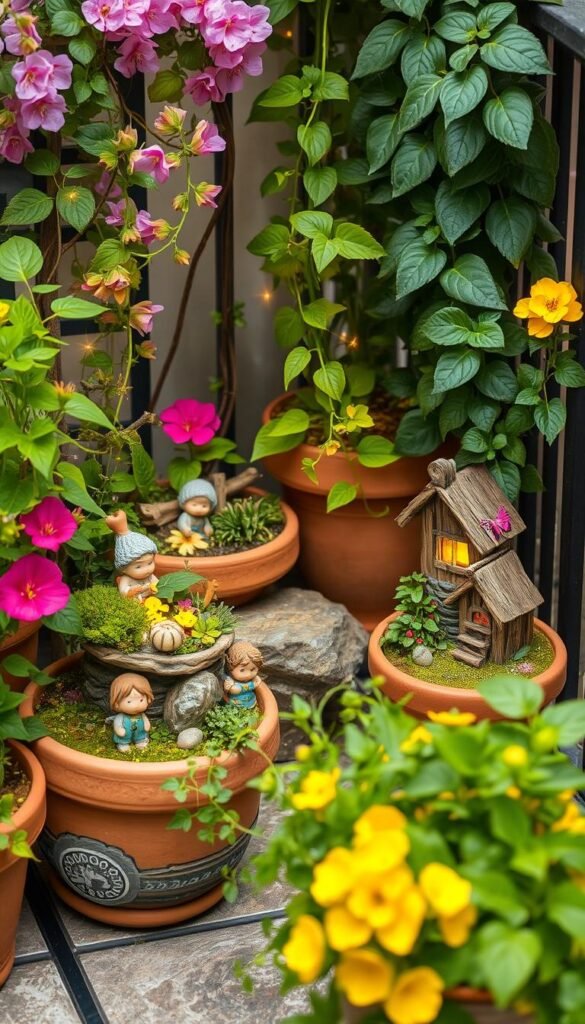Imagine stepping outside to a personal oasis where magic feels tangible and nature sparkles with charm. You don’t need sprawling lawns to create this experience — even compact patios or apartment balconies can become gateways to whimsy. With clever design and the right containers, you can craft enchanting miniature worlds that transform overlooked corners into vibrant escapes.
Urban living often means working with limited square footage, but that’s no barrier to creativity. Tiny landscapes thrive in containers, letting you layer textures, colors, and playful accents. Think mossy pathways winding past pint-sized benches or pebble streams flowing beneath fairy-sized bridges. These details turn ordinary planters into storytelling canvases.
Why does this matter? Studies show interacting with nature reduces stress, and tending a miniature garden offers daily moments of calm. For city dwellers, it’s a chance to reconnect with greenery while expressing personal style. The best part? You control the scale, choosing plants and decor that suit your light conditions and maintenance preferences.
This guide walks through every step — from selecting weather-resistant pots to arranging elements for maximum visual impact. You’ll learn how to balance proportion, create depth, and choose materials that withstand outdoor conditions. Let’s turn your compact outdoor area into a sanctuary that sparks joy every time you step outside.
Embrace the Magic: Start Your Fairy Garden Adventure
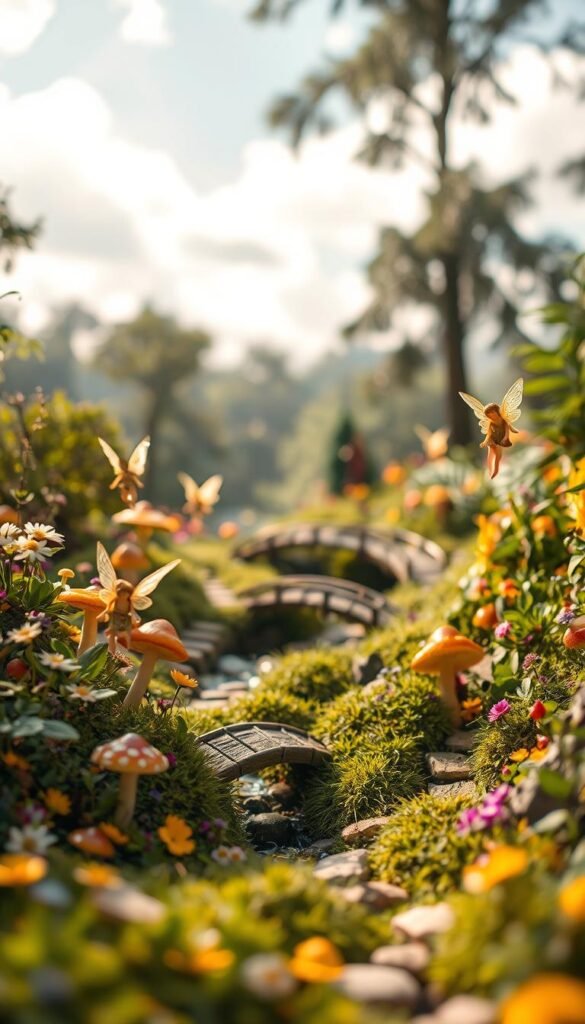
Unleash your creativity by turning a simple container into a magical realm where every plant tells a story. Think of your pot as a blank page waiting for whimsical details—tiny doors, winding paths, or glittering stones.
This isn’t just gardening—it’s world-building. Let your inner child pick elements that spark joy: a miniature bench under mossy “trees” or a pebble river leading to nowhere. There are no rules here. One study found that playful activities reduce stress by 28%, making this hobby both fun and functional.
| Traditional Gardening | Fairy Gardening |
|---|---|
| Focuses on plant health | Blends flora with fantasy |
| Static layouts | Evolving stories |
| Single-purpose spaces | Interactive tiny worlds |
Your creation grows with you. Add a ceramic toadstool today, a tiny lantern next week. Over time, these additions weave together into a living narrative. One gardener shared, “It’s like writing a book where the chapters change with the seasons.”
Remember: perfection isn’t the goal. A crooked path or mismatched colors? That’s where the fairies hide their charm. This is your escape—a place where imagination blooms faster than weeds.
Selecting the Perfect Containers for Your Miniature Wonderland
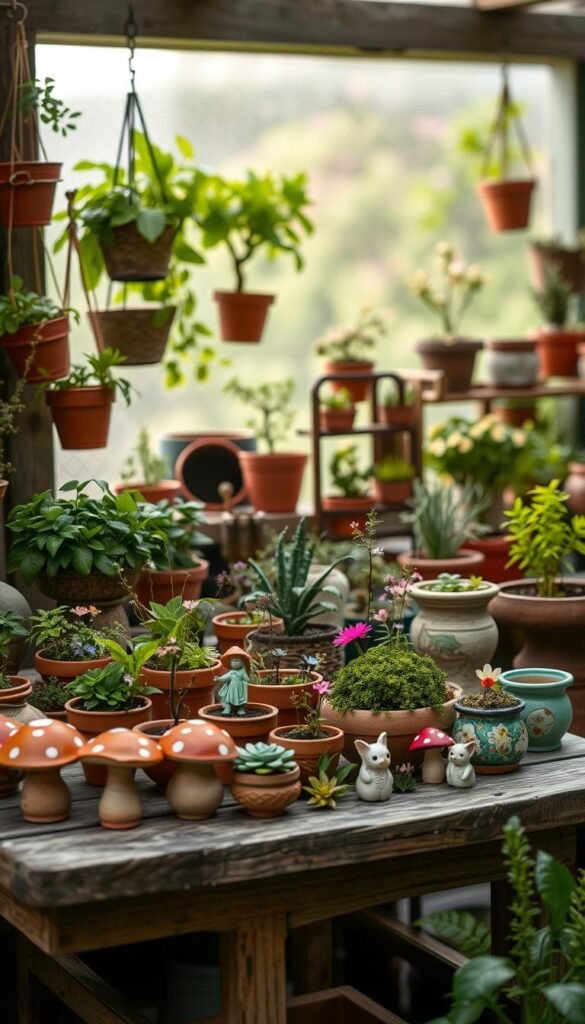
Your choice of container sets the stage for your miniature escape. Whether you’re using a weathered crate or a glossy ceramic pot, this vessel becomes the foundation of your tiny world.
Look for items that spark joy and fit your available space. Rectangular planters hug balcony rails neatly, while round pots create focal points on tabletops. One gardener transformed an antique toolbox into a cascading garden, proving creativity trumps tradition.
Consider these factors when choosing:
- Drainage: Drill holes if needed—roots hate soggy feet
- Depth: 6-8 inches lets plants thrive without overcrowding
- Style: Rough terracotta whispers rustic charm, while sleek metal shouts modern edge
Unexpected finds work wonders. A chipped birdbath becomes an elevated paradise, its bowl cradling succulents like jewels. “My best planter started as a thrift store mistake,” admits urban gardener Lisa Chen. Her $3 find now hosts mossy hills and a miniature stone bridge.
Match your container’s personality to your vision. Wide bowls let scenes sprawl, while tall urns suggest vertical drama. Remember: this isn’t just a pot—it’s the first chapter of your living storybook.
Crafting a Whimsical Fairy House Centerpiece
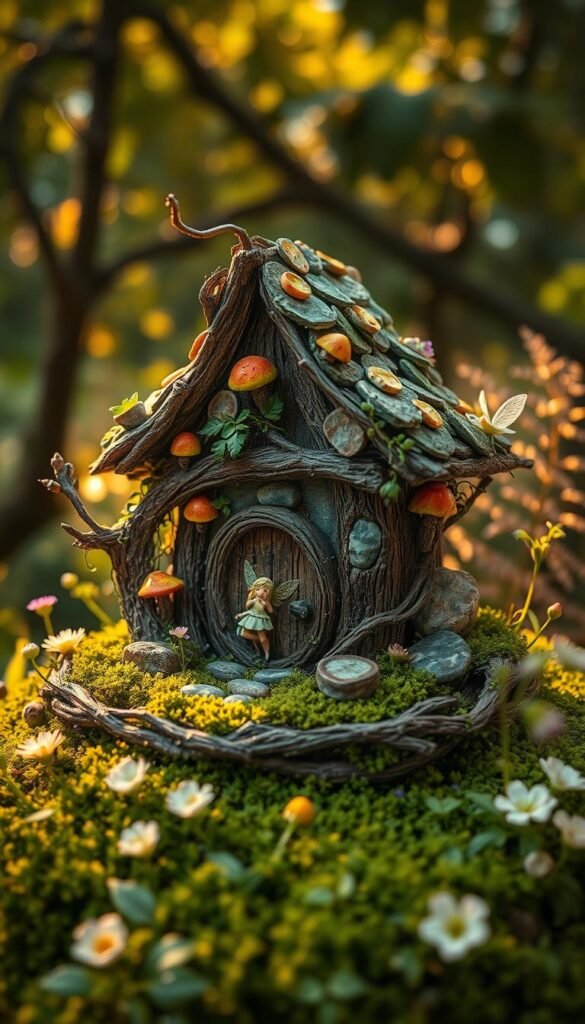
The heart of your miniature landscape beats within its tiny dwelling. A fairy house isn’t just decor—it’s the soul of your scene, pulling together colors, textures, and storytelling. Whether you prefer moss-covered cottages or glittering mushroom domes, this centerpiece determines your garden’s personality.
Start by choosing a style that sparks joy. Rustic tree-stump designs blend seamlessly with natural themes, while cottages with mini shuttered windows suggest cozy woodland charm. For modern spaces, try sleek ceramic houses with geometric patterns. One gardener shared, “My cobblestone cottage makes the whole planter feel alive—like someone’s home.”
| Style | Materials | Best Suited For |
|---|---|---|
| Tree-Stump | Resin, wood | Natural or woodland themes |
| Cottage | Ceramic, stone | Storybook-inspired designs |
| Modern | Metal, glass | Urban or minimalist spaces |
Placement matters. Position your house slightly off-center to create depth, leaving space for trailing plants or a pebble path. In compact patio designs, elevate smaller houses on stones to maximize visibility.
Always check proportions—your house should occupy 1/3 of the container’s width. Weather-resistant resin or ceramic options withstand rain and sun, keeping the magic intact season after season. Remember: when your centerpiece shines, the whole garden glows.
Designing with Drainage in Mind for a Thriving Garden
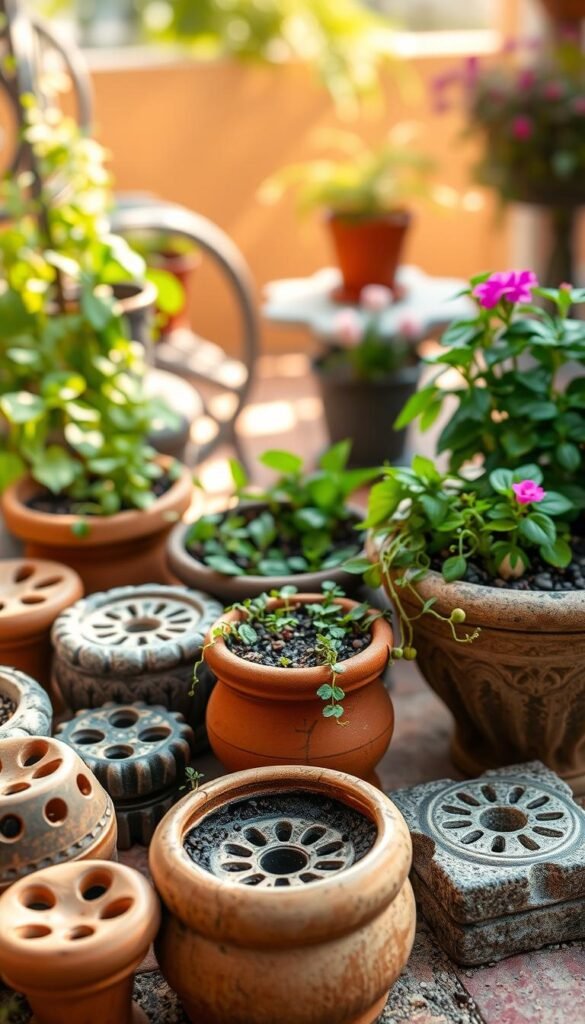
Healthy roots need air as much as water—that’s where smart drainage comes in. Without it, your tiny paradise becomes a swampy mess. Let’s build a foundation that keeps plants happy and scenes vibrant.
Ensuring Proper Drainage with Rocks and Holes
Drainage holes are non-negotiable. If your container lacks them, grab a drill—ceramic and plastic pots can handle small holes. Line the bottom with gravel or broken pottery pieces. This layer acts like a sponge, soaking up excess moisture.
| Material | Benefits | Best For |
|---|---|---|
| Pea Gravel | Allows airflow | Shallow containers |
| Clay Shards | Recycles old pots | Deep planters |
| Lava Rocks | Prevents soil compaction | Heavy rain areas |
The Role of Landscape Fabric in Soil Health
Place landscape fabric over your rock layer. It’s like a sieve—water flows through, but soil stays put. No fabric? Coffee filters work perfectly. Urban gardener Marco Reyes shares: “I use leftover burlap scraps. Free and eco-friendly!”
This simple step prevents root rot and stops pests from nesting in soggy dirt. Your plants get consistent moisture without drowning. Now add soil, and watch your miniature world flourish.
Choosing the Right Plants for Lush Mini Landscapes
Scale is everything when crafting living dioramas in containers. The trick? Selecting plants that stay naturally petite while mimicking full-sized ecosystems. Imagine tiny “trees” formed by rosemary sprouts or mossy “meadows” spreading across your planter’s floor.
Ground Covers That Transform Tiny Spaces
Irish moss becomes velvet-like lawns, while baby tears form pillowy cushions perfect for shady corners. These low-growing varieties create depth without overwhelming your scene. For sunny spots, try creeping thyme—its fragrant leaves release herbal scents when brushed.
- Light lovers: Sedum, hens-and-chicks, dwarf mondo grass
- Shade seekers: Miniature ferns, polka dot plant, selaginella
- Trailing plants: String of pearls, creeping fig, lemon button fern
Combine textures for visual intrigue. Pair feathery moss with succulent rosettes, or let trailing varieties spill over edges like living waterfalls. Urban gardener Elena Torres notes: “My west-facing balcony garden uses stonecrop as ‘boulders’ and woolly thyme as ‘grass’—it looks like a mountain valley in a bowl.”
Remember—slow growth means less pruning. Choose species that mature under 6 inches tall, ensuring your miniature world stays perfectly proportioned all season.
Fairy Garden Pots for Patios and Balconies: Making the Most of Small Areas
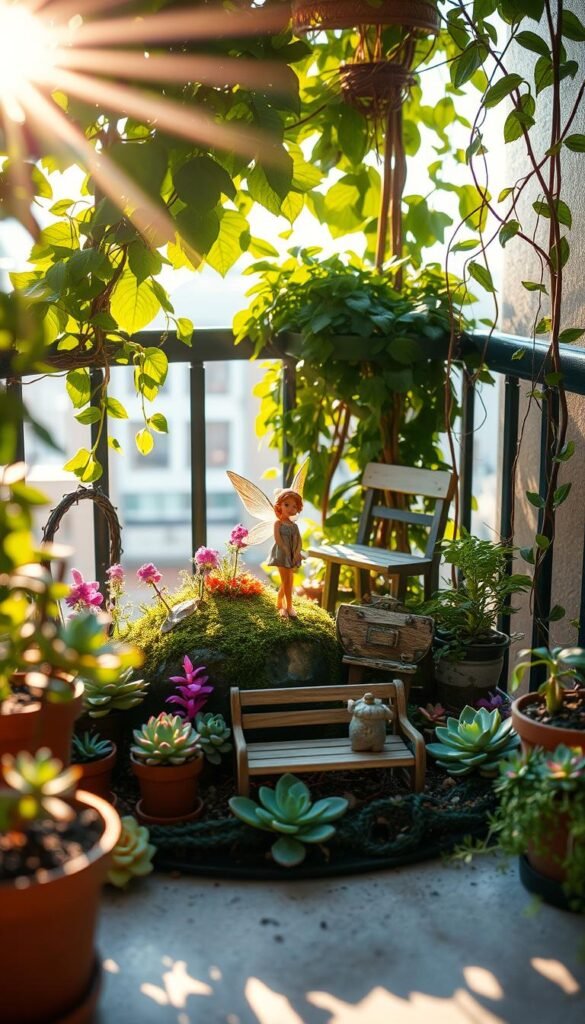
Transform cramped corners into enchanting escapes with clever space-saving tactics. Start by thinking upward—hang lightweight planters from railings or mount wall pockets to free up floor space. Stack tiered containers to create vertical layers, letting trailing plants like creeping thyme spill over edges for dynamic movement.
Mirrors work wonders in tight spots. Position one behind your arrangement to double the visual depth. One gardener noted, “Reflective surfaces make my 4-foot balcony feel like a secret forest clearing.” Pair this trick with miniature furniture placed at angles to guide the eye through the scene.
Mobility matters. Use lightweight resin pots with built-in handles for easy relocation. Rotate your creation to chase sunlight or shield delicate plants from harsh winds. For patio container gardening, opt for wheeled plant stands—they let you rearrange layouts in seconds when hosting guests.
Balance lushness with practicality. Choose airy plants like succulents or dwarf herbs to keep weight low. Secure tall decor with waterproof glue to prevent tipping. Remember: even tiny worlds need breathing room. Leave gaps between elements to maintain that magical “lived-in” feel without overcrowding.
Exploring Unique Upcycled Container Ideas
Breathing new life into forgotten items adds character to your tiny landscapes while reducing waste. Upcycled containers tell stories through their imperfections—a cracked teacup becomes a cottage, weathered boots transform into quirky planters.
Repurposing Birdcages, Teacups, and Old Boots
Thrift store birdcages shine as airy planters. Their open wire frames let ivy spill through bars while tiny lanterns dangle inside. One gardener shared: “I added a mini swing—now it looks like fairies play there at night.”
| Item | Best Use | Pro Tip |
|---|---|---|
| Birdcage | Hanging displays | Line with moss for moisture retention |
| Rain Boots | Vertical gardens | Drill drainage holes in soles |
| Teacups | Tabletop scenes | Group 3+ for a “tea party” effect |
Children’s outgrown boots make playful DIY containers. Their compact size is ideal for first-time projects. Fill them with drought-tolerant sedum—no watering worries. For indoor setups, teacups hold delicate moss gardens. Arrange them on shelves for instant charm.
Upcycling cuts costs and sparks creativity. As one budget-friendly container guide notes: “Your best planter might be hiding in the attic.” These unique pieces become conversation starters, blending sustainability with storytelling magic.
Maximizing Vertical Space with Hanging and Wall-Mounted Planters
Unlock hidden growing areas by shifting your gaze upward. Walls, railings, and ceilings become prime real estate when floor space disappears. Hanging baskets burst with trailing lobelia, while wall-mounted systems host cascading succulents that dance in the breeze.
Start with railing-mounted boxes—they’re perfect for herbs like thyme or oregano. Use sturdy brackets rated for 15+ pounds to handle waterlogged soil. For brick walls, try adhesive hooks designed for outdoor use. One urban gardener notes: “My ivy-covered trellis planter makes my fire escape feel like a secret jungle.”
| Planter Type | Best Features | Ideal Plants |
|---|---|---|
| Hanging Baskets | 360° visibility | Petunias, fuchsias |
| Wall Pouches | Modular design | Strawberries, sedum |
| Railing Boxes | Space-saving | Basil, dwarf marigolds |
Choose plants that thrive in elevated positions. Silver falls dichondra spills like liquid mercury, while creeping jenny adds golden accents. These living curtains soften hard surfaces and create depth.
Vertical arrangements do more than save space—they transform bland walls into dynamic ecosystems. Urban gardener Mia Tran shares: “My tiered planters make my balcony feel three times larger.” Layer heights for drama, placing taller elements at the back and spillers near edges.
Adding Whimsy with DIY Fairy Lights and Accents
Twilight transforms your miniature escape into a glowing sanctuary. Solar-powered LEDs wrapped around tiny cottages cast delicate shadows, while bottle-cap lanterns add pops of color along pebble paths. These touches make your creation look alive long after sunset.
Try weaving copper wire lights through creeping thyme—they’ll sparkle like dewdrops at morning light. For quick DIY magic, fill mason jars with battery-operated fairy strands. Bury them halfway in moss to mimic will-o’-the-wisp glow.
Smart placement matters. Cluster lights near focal points—a miniature porch swing or ceramic bridge. One gardener shares: “My solar stakes guide imaginary fairies home each night.” Rotate accents seasonally: pastel eggs in spring, amber leaves in fall.
These luminous details do more than beautify. They extend your enjoyment into cool evenings, turning compact spaces into retreats that calm the mind. Let your creativity shine—literally.

